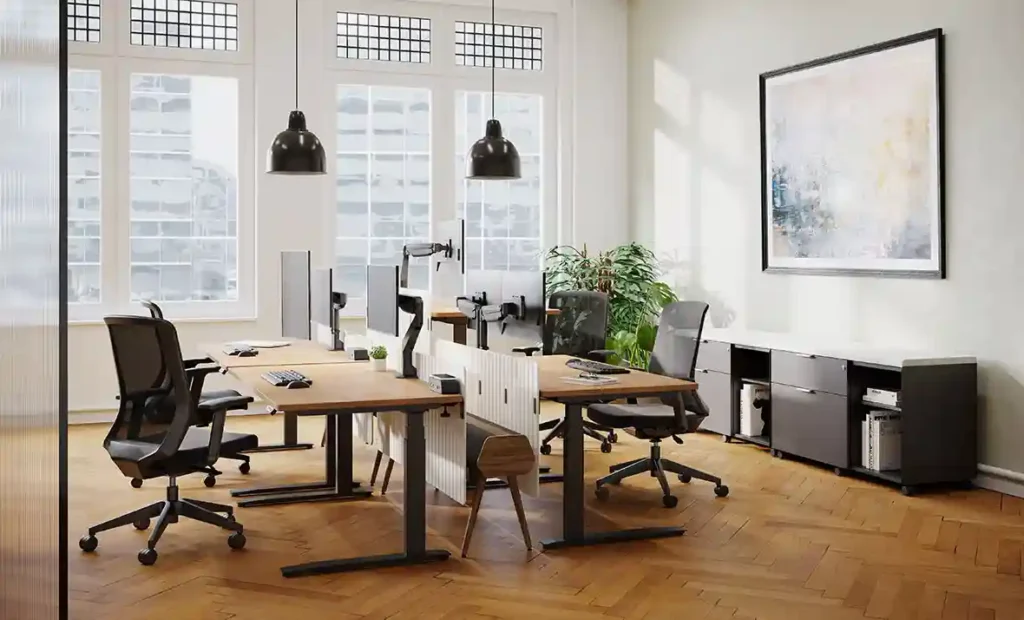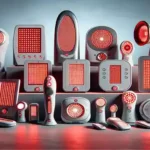Your workspace affects how you feel. It changes how much work you get done. A good workspace makes you happy. A bad one makes you tired and stressed.
Many people spend 8 hours a day at work. Your office should help you, not hurt you. The right setup boosts your energy. It helps you think better. It keeps you healthy too.
This guide shows you how to fix your workspace. You will learn 10 simple ways to make it better. These tips work for home offices. They work for regular offices too.
What Makes a Great Workspace?

A great workspace has three things. First, it keeps you comfortable. Second, it looks nice. Third, it helps you work better.
Comfort means your body feels good. You sit well. Your eyes don’t hurt. Your back doesn’t ache.
Good looks mean you enjoy being there. Nice colors make you happy. Plants make you calm. Personal items make you smile.
Better work happens when everything flows. You find things fast. You focus longer. You feel creative and smart.
Strategy 1: Set Up Your Body Right
Why Your Body Matters
Your body tells you when something is wrong. Back pain means bad sitting. Neck pain means bad screen height. Wrist pain means bad typing position.
Good body setup prevents pain. It stops problems before they start. You feel better all day long.
Fix Your Chair
Your chair is very important. It holds you for many hours. A bad chair hurts your back. A good chair supports you.
Chair Setup Steps:
- Sit all the way back
- Feet flat on the floor
- Knees bend at 90 degrees
- Arms rest at elbow height
- Back touches the chair support
What to Look For:
- Height goes up and down
- Back support moves
- Armrests move too
- Wheels roll smooth
- Cushion stays firm
Fix Your Desk Height
Your desk height affects your arms. Too high makes shoulders hurt. Too low makes you hunch over.
Right Desk Height:
- Elbows bend at 90 degrees when typing
- Wrists stay straight
- Shoulders stay relaxed
- Arms don’t reach up or down
- Space for your legs underneath
Fix Your Screen
Screen position affects your neck. Too high makes you look up. Too low makes you look down. Both hurt your neck.
Screen Setup Rules:
- Top of screen at eye level
- Screen 20 inches away from your face
- Tilt back just a little
- No glare from windows
- Big enough to read easy
Laptop Users:
- Use external keyboard and mouse
- Raise laptop screen higher
- Get a laptop stand
- Consider second monitor
- Keep good distance
Strategy 2: Get Good Light
Why Light Matters
Light affects your mood. Bright light makes you alert. Dim light makes you sleepy. Bad light hurts your eyes.
Natural light is best. It helps your body clock. It gives you energy. It makes colors look real.
Use Natural Light
Windows give the best light. Try to sit near one. Face sideways to avoid glare. Keep windows clean.
Make Natural Light Better:
- Light colored walls bounce light around
- Mirrors reflect light to dark spots
- Sheer curtains let light through
- Remove things blocking windows
- Clean windows often
Best Window Positions:
- Side lighting works best
- Avoid facing bright windows
- Avoid having windows behind your screen
- Use blinds to control brightness
- Change position as sun moves
Add Good Electric Light
You need electric light when natural light is not enough. Different tasks need different light amounts.
Types of Light You Need:
- Overhead light for general room lighting
- Desk lamp for close work
- Floor lamp for room corners
- Under-cabinet lights for keyboards
- Accent lights for mood
Pick Good Bulbs:
- LED bulbs last longer and use less power
- Warm white light feels comfortable
- Avoid harsh white light
- Get dimmable bulbs
- Choose bulbs that don’t flicker
Light Placement Tips:
- Put light sources at different heights
- Avoid shadows on your work
- Light should come from multiple directions
- Use indirect light when possible
- Adjust brightness during the day
Strategy 3: Add Plants and Natural Things
Why Nature Helps
Nature makes people feel good. Plants clean the air. They add humidity. They reduce stress. Green colors calm your mind.
Wood and stone connect you to nature. They feel warm and real. They make spaces feel alive.
Pick Easy Plants
Some plants need lots of care. Others grow with little help. Pick easy ones for your first plants.
Best Beginner Plants:
- Snake plants need water once a month
- Pothos grow in any light
- ZZ plants survive without much water
- Spider plants make baby plants
- Succulents need almost no care
Plant Care Basics:
- Check soil with your finger
- Water when soil feels dry
- Put plants near light sources
- Turn plants so all sides get light
- Clean dust off leaves monthly
Add Natural Materials
Natural materials feel different than plastic. They look better over time. They connect you to the earth.
Wood Elements:
- Wooden desk tops
- Bamboo organizers
- Cork boards for notes
- Wood picture frames
- Natural wood shelves
Stone and Earth Elements:
- Stone paper weights
- Ceramic coffee mugs
- Clay plant pots
- Natural fiber rugs
- Woven storage baskets
Bring in Nature Sounds
Nature sounds help you focus. They cover up distracting noises. They make you feel outdoors.
Nature Sound Ideas:
- Small water fountain on desk
- Sound machine with rain sounds
- Wind chimes near windows
- Fish tank with filter sounds
- Apps with forest sounds
Strategy 4: Make Your Space Flexible
Why Flexible Helps
Different tasks need different setups. Writing needs focus. Calls need quiet. Creative work needs movement.
Flexible spaces change with your needs. You can stand or sit. You can spread out or focus in. You control your environment.
Get Moving Furniture
Fixed furniture stays in one place. Moving furniture goes where you need it. This gives you more options.
Furniture That Moves:
- Rolling desk chairs
- Carts with wheels for supplies
- Folding tables for extra space
- Stools that stack up
- Portable lap desks
Height-Changing Options:
- Standing desk converters
- Adjustable monitor arms
- Keyboard trays that move up and down
- Stools with height adjustment
- Tables with different heights
Create Different Work Areas
One big desk doesn’t work for everything. Different areas work better for different tasks.
Areas to Consider:
- Quiet zone for focused work
- Meeting area for video calls
- Creative zone for brainstorming
- Relaxation spot for breaks
- Storage area for supplies
How to Make Areas:
- Use different lighting in each area
- Put rugs under furniture groups
- Use plants as natural dividers
- Different colors for different zones
- Arrange furniture to create boundaries
Smart Storage Solutions
Storage should work hard. One piece should do many jobs. This saves space and money.
Multi-Use Storage:
- Ottoman that holds files
- Shelves with built-in lights
- Desk with drawers underneath
- Cabinets that hold printers
- Walls with hanging storage
Strategy 5: Make Zones for Different Tasks
Plan Your Space by Task
Think about what you do all day. List your main activities. Give each one its own space.
Most people need these zones. Focus work. Meeting space. Creative thinking. Break time. Storage.
Set Up a Focus Zone
Focus work needs quiet. It needs few distractions. Everything you need should be close.
Focus Zone Needs:
- Comfortable chair for long sitting
- Good task lighting
- All supplies within reach
- Minimal visual distractions
- Sound control
Creating Quiet:
- Face away from busy areas
- Use soft materials to absorb sound
- Add plants to muffle noise
- Close doors when possible
- Use white noise if needed
Create Meeting Space
Video calls are part of most jobs now. You need a space that looks professional. Good lighting and sound matter.
Meeting Setup:
- Clean background behind you
- Good lighting on your face
- Stable internet connection
- Quality camera and microphone
- Comfortable seating for longer calls
Background Ideas:
- Bookshelf with organized books
- Plain wall with one piece of art
- Plants arranged nicely
- Company logo or awards
- Simple, uncluttered space
Design Creative Areas
Creative work needs different energy. More space to spread out. Inspiring visuals. Room to think.
Creative Zone Elements:
- Large work surface
- Wall space for posting ideas
- Good natural light
- Inspiring colors and objects
- Easy-to-move furniture
Tools for Creativity:
- Whiteboards for brainstorming
- Cork boards for inspiration
- Colored pens and markers
- Sticky notes in many colors
- Large paper for sketching
Build Break Spaces
Your brain needs breaks. Short breaks make you more productive. Longer breaks prevent burnout.
Break Area Setup:
- Comfortable seating different from work chair
- Soft lighting
- Relaxing colors
- Personal photos or art
- Plants or nature views
Break Activities:
- Light stretching
- Deep breathing
- Healthy snacking
- Reading something fun
- Looking out windows
Strategy 6: Use Technology Wisely
Make Technology Work for You
Technology should make work easier. It should not create more problems. Good technology disappears into the background.
Keep wires organized. Use wireless when possible. Pick tools that save time.
Control Your Cables
Messy cables look bad. They collect dust. They get tangled. They make you look unprofessional.
Cable Solutions:
- Cable trays under desks
- Clips to hold cables in place
- Sleeves to bundle cables together
- Wireless devices when possible
- Power strips with USB ports
Organization Tips:
- Label cables with their purpose
- Use different colored cables for different devices
- Keep extra length coiled neatly
- Route cables along furniture edges
- Use adhesive clips on desk edges
Pick Helpful Apps
Apps can help you work better. They can also distract you. Choose apps that truly help.
Productivity Apps:
- Timer apps for focused work sessions
- Task lists to track what you need to do
- Calendar apps to plan your day
- Note-taking apps for ideas
- File organization apps
Health Apps:
- Break reminder apps
- Posture tracking apps
- Blue light filters for screens
- Exercise apps for desk stretches
- Sleep tracking apps
Set Up Good Charging
Dead devices stop your work. Good charging keeps everything powered up.
Charging Setup:
- Wireless charging pads on desk
- USB ports built into power strips
- Cable organizers near charging areas
- Backup cables in desk drawers
- Portable battery packs for emergencies
Strategy 7: Use Colors That Help You Work
How Colors Affect You
Colors change how you feel. They affect your energy and focus. Different colors help different types of work.
Blue helps you think clearly. Green reduces eye strain. Yellow boosts creativity. White feels clean and organized.
Pick Your Main Colors
Your main colors set the mood for your whole space. Pick colors that match how you want to feel.
Colors for Focus:
- Blue shades help concentration
- Gray creates calm feelings
- White makes spaces feel larger
- Beige feels warm and stable
- Soft green reduces stress
Colors for Energy:
- Yellow stimulates creativity
- Orange encourages social interaction
- Light green feels fresh and alive
- Coral adds warmth without being too strong
- Light purple inspires innovation
Add Personal Touches
Personal items make your space yours. They remind you why you work. They make you happy.
Personal Items to Display:
- Family photos in nice frames
- Awards or certificates you earned
- Art that inspires you
- Objects from travels
- Gifts from people you care about
Inspiration Elements:
- Quotes that motivate you
- Vision boards with your goals
- Books that changed your thinking
- Plants you grew yourself
- Handmade items
Balance Your Visuals
Too much visual stuff creates chaos. Too little feels cold. Find the right balance for you.
Visual Balance Rules:
- Group items in odd numbers
- Leave some empty space
- Mix different heights and sizes
- Use consistent color schemes
- Create one main focal point
Strategy 8: Keep Air Clean and Temperature Right
Why Air Quality Matters
Bad air makes you tired. It gives you headaches. It makes thinking harder. Clean air helps you feel and work better.
Temperature affects comfort. Too hot makes you sleepy. Too cold makes you tense. Just right helps you focus.
Improve Your Air
Most indoor air has problems. It might be too dry. It might have dust. It might not move enough.
Air Improvement Steps:
- Open windows when weather is nice
- Use fans to move air around
- Add plants that clean air
- Keep air filters clean
- Avoid strong chemical smells
Air-Cleaning Plants:
- Spider plants remove formaldehyde
- Peace lilies filter multiple toxins
- Rubber trees absorb airborne chemicals
- Boston ferns add humidity
- Aloe plants improve air overnight
Control Temperature
Different people like different temperatures. Find what works for you. Make small adjustments as needed.
Temperature Tips:
- Most people work best between 68-72°F
- Layer clothing for easy adjustment
- Use small fans for personal cooling
- Space heaters for personal warming
- Monitor temperature throughout the day
Manage Humidity
Dry air hurts your skin and breathing. Too much humidity feels sticky. Middle amounts feel best.
Humidity Solutions:
- Plants add natural humidity
- Small humidifiers for dry air
- Dehumidifiers for too much moisture
- Monitor humidity with simple gauges
- Aim for 40-60% humidity
Strategy 9: Design for Movement
Why Movement Matters
Sitting all day hurts your body. It slows your blood flow. It weakens your muscles. It affects your mood.
Movement keeps you healthy. It boosts energy. It helps you think better. It prevents many health problems.
Add Standing Options
Standing burns more calories than sitting. It improves posture. It increases alertness. Start with short periods.
Standing Desk Options:
- Desk converters that sit on regular desks
- Full standing desks that adjust height
- Tall tables for standing work
- Wall-mounted fold-down desks
- Standing desk accessories
Standing Tips:
- Start with 15-minute periods
- Use anti-fatigue mats
- Wear comfortable shoes
- Keep monitor at eye level
- Shift weight between feet
Encourage Regular Movement
Set up your space to make movement natural. Put things in different places. Take walking breaks. Stretch often.
Movement Ideas:
- Put printer across the room
- Use stairs instead of elevators
- Walk during phone calls
- Stretch between tasks
- Set movement reminders
Exercise Equipment for Desks:
- Under-desk elliptical machines
- Balance balls instead of chairs
- Resistance bands in drawers
- Foam rollers for break time
- Yoga mats for stretching
Plan Active Breaks
Short active breaks work better than long sitting periods. Your body and brain need the change.
5-Minute Break Ideas:
- Walk around the building
- Do desk stretches
- Look out windows at distant objects
- Deep breathing exercises
- Light calisthenics
15-Minute Break Ideas:
- Take a walk outside
- Do a full stretching routine
- Climb stairs
- Do yoga poses
- Simple strength exercises
Strategy 10: Stay Organized and Clean
Why Organization Helps
Messy spaces create stress. They waste time. They make you look unprofessional. They prevent good thinking.
Clean, organized spaces feel peaceful. You find things fast. You think more clearly. You feel in control.
Daily Organization Habits
Good organization happens every day. Small daily actions prevent big messes. Build these habits slowly.
Daily Cleaning Tasks:
- Clear desk surface before leaving
- Put tools back where they belong
- File papers immediately after use
- Empty trash when full
- Wipe down surfaces weekly
Weekly Organization Tasks:
- Sort through papers and files
- Clean computer desktop
- Organize digital files
- Deep clean workspace
- Plan next week’s priorities
Smart Storage Systems
Everything needs a home. When items have specific places, you find them fast. You also put them away fast.
Storage Principles:
- Items used daily stay within arm’s reach
- Items used weekly go in desk drawers
- Items used monthly go in nearby cabinets
- Items used rarely go in storage areas
- Label everything clearly
Storage Solutions:
- Drawer dividers for small items
- Vertical file holders for papers
- Desktop organizers for daily tools
- Wall-mounted shelves for reference materials
- Rolling carts for supplies
Digital Organization
Digital messes cause as much stress as physical ones. Organize your computer like you organize your desk.
Computer Organization:
- Create logical folder structures
- Use consistent file names
- Delete files you don’t need
- Back up important files regularly
- Organize bookmarks and shortcuts
Email Management:
- Check email at set times
- Respond immediately or file for later
- Use folders to sort messages
- Unsubscribe from unwanted lists
- Keep inbox under 20 messages
How to Start Your Workspace Makeover
Begin with Small Changes
Don’t try to change everything at once. Pick one area to improve. Make it perfect. Then move to the next area.
Week 1: Fix your seating and desk height. Week 2: Improve your lighting. Week 3: Add plants and organize. Week 4: Create different zones.
Make a Budget Plan
Some improvements cost nothing. Moving furniture around is free. Cleaning and organizing cost nothing. Other improvements need money.
Free Improvements:
- Rearrange existing furniture
- Clean and organize everything
- Use natural light better
- Remove items you don’t need
- Change your daily habits
Low-Cost Improvements:
- Add plants and natural elements
- Buy organizational supplies
- Get a good desk lamp
- Add personal decorative items
- Improve cable management
Medium-Cost Improvements:
- Buy ergonomic accessories
- Get an air purifier
- Add storage furniture
- Upgrade lighting fixtures
- Purchase productivity tools
Track Your Progress
Notice how changes affect you. Do you feel better? Do you work better? Are you happier? Keep what works. Change what doesn’t.
Things to Notice:
- Energy levels throughout the day
- How long you can focus
- Physical comfort and pain levels
- Mood and stress levels
- Work quality and productivity
Conclusion
These 10 Strategies for Crafting a Balanced and Inspiring Workspace work. Start with one small change today. Your workspace affects your mood, health, and productivity. Good setups boost energy and focus. Bad ones cause stress and pain. Pick strategies that fit your needs. Make changes slowly. Be patient with the process. Every improvement counts. Your future self will thank you. A better workspace means better work and better health.






